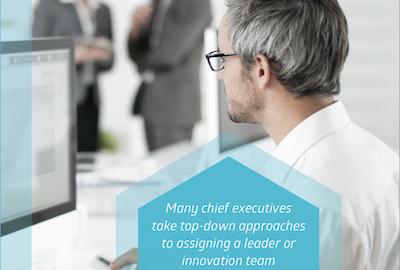#Digital #Transformation: not a destination but a journey
Digital transformation represents the quest to understand how “disruptive technology” affects the customer experience
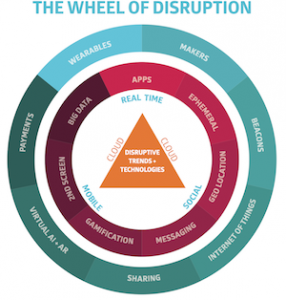
Golden Triangle of Disruption
Digital transformation is not a goal in itself, but a continuous journey, serving to learn more about the relationship between technology and customer behavior to earn relevance among them. Altimeter Group defines digital transformation as “the re-alignment of, or new investment in, technology and business models to more effectively engage digital consumers at every touchpoint in the customer experience lifecycle”, while social media struggles to prove its business impact alone.
Digital transformation though is not the simple focus on technology investments in order to solve problems, but also the involvement of changing from the inside out with the help of catalysts who forces the companies to recognize its importance. Strategists with broader digital expertise, however, are needed to align technology and business strategies across departments and teams, helping aid in delivering results against over-arching business goals, which forms the essence of this domain.
Here are several key findings in this domain: the development of the disruptive technologies and the evolution of customer behavior necessitate bigger changes than initially anticipated, with the objective of optimizing the digital customer experience, and the effectiveness will be improved via pointed vision and supportive leadership; but still, the digital transformation remains in its infancy.
What can companies benefit from digital transformation? An updated company vision; a thriving culture of innovation; an improved customer journey, conversion and loyalty; a greater competitive advantage; an increased internal collaboration and efficiency; more empowered workforce; a deeper data analysis…
Mobile and real-time marketing join social in disrupting business models that cannot keep up with more connected, nimble, and informed customers
The Golden Triangle of Disruption, defined by real-time, social media and mobile technology trends, alters completely how people connect and communicate, and in turn affects the customer journey and lifecycle.
To better understand customer journey, the Intuit team needs to invest in not only demographics but also psychographics (i.e., shared behaviors and interests) to create accurate buyer personas
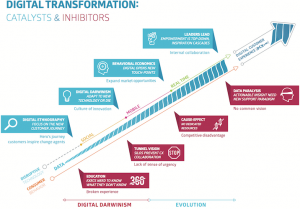
Catalysts & Inhibitors
Digital transformation inhibitors
Each department often acts as its own fiefdom, designing and managing their respective touchpoints differently and adhering to differing standards and metrics, causing disjointed customer experience and friction, with many abandoning the journey before the can complete the desired task.
Empowering and education existing teams on the value of digital transformation proves difficult when everyone is not on the same digital page. The key to transformation is to invest time and effort in helping leadership fully understand the implications of the structural shift happening around its customers right now. In order to unlock new customer behaviors and preferences, data should be representing the key among all the other problems.
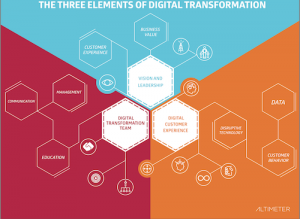
Elements of Digital Transformation
Elements of digital transformation
There are three main elements of digital transformation:
- Vision and leadership, mostly because that this domain is in progress and requires leading. A digital transformation begins with a vision where business value and customer experience convene to deliver mutual benefits with the executive support from the strategists, the updated vision and the role played by the change agent.
- Digital transformation team, or digital circles, Centers of Excellence (CoE), rapid innovation teams, digital acceleration teams (DAT), etc., with an organizational structure and a partnership with the IT department, in order to understand and solve for problems and opportunities around mobile, social, and digital; and discuss the voice of the customer (VOC) and fit in with it. To make this team efficient, the leader should make the team members feel a sense of ownership in the process.
- Digital customer experience, by aligning people, processes and technologies against goals and milestones to map a new and effective journey, with the assistance regarding holistic CX focus; culture of innovation (about unplanned product); data integration (with touchpoints, business units and customer expectations); internal collaboration; and “digital-first” mindset (consider technology’s effect on behavior and expectations). “Mapping the customer journey is a journey in and of itself.”
What’s also essential in the progress of digital transformation for a company is that CMOs and CIOs share ownership of goals and outcomes so that IT and marketing can expedite change while accelerating initiatives that optimize digital customer journeys and experiences. The IT team, too, can take charge by reaching out to business units, marketing teams, and key functions to lean how to help them achieve long- and short-term business goals, and therefore aids in expediting digital transformation and advancing business outcomes.
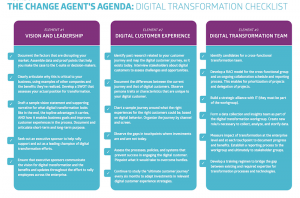
Digital Transformation Checklist
To resume
While digital transformation and DCX approaches are developing, there are many roles needed to manage how businesses recognize the opportunities to change and also help lead the efforts to do so. Companies will need the support of executives, strategists, change agents, and trusted external partners to learn, collaborate, and lead.
In its own way, digital transformation is making businesses more human. As such, digital transformation is not a destination. Instead, it’s a journey that continually seeks out how to use technology in ways that improve customer experiences and relationships. Digital transformation also represents an effort that introduces new models for business and, equally, creates a way of staying in business as customers become increasingly digital.
Source:
« http://altimetergroupdigitaltransformation.com/img/dt-report.pdf » Digital Transformation: Why and how companies are investing in new business models to lead digital customer experiences
————————————–
Authored by :
 Huansha YIN
Huansha YIN
Chargée de communication et de marketing (stagiaire) chez SpotPink. Je suis actuellement en Master 1 de Psychologie, Environnement et Menaces Sociales à l’université Paris Descartes. Véritablement intéressée par le domaine de la communication, j’explore ce sur quoi peut intervenir la psychologie dans ce domaine. Passionnée de cinéma et de voyage, j’aime faire la découverte de nouvelles cultures et de nouvelles langues.

